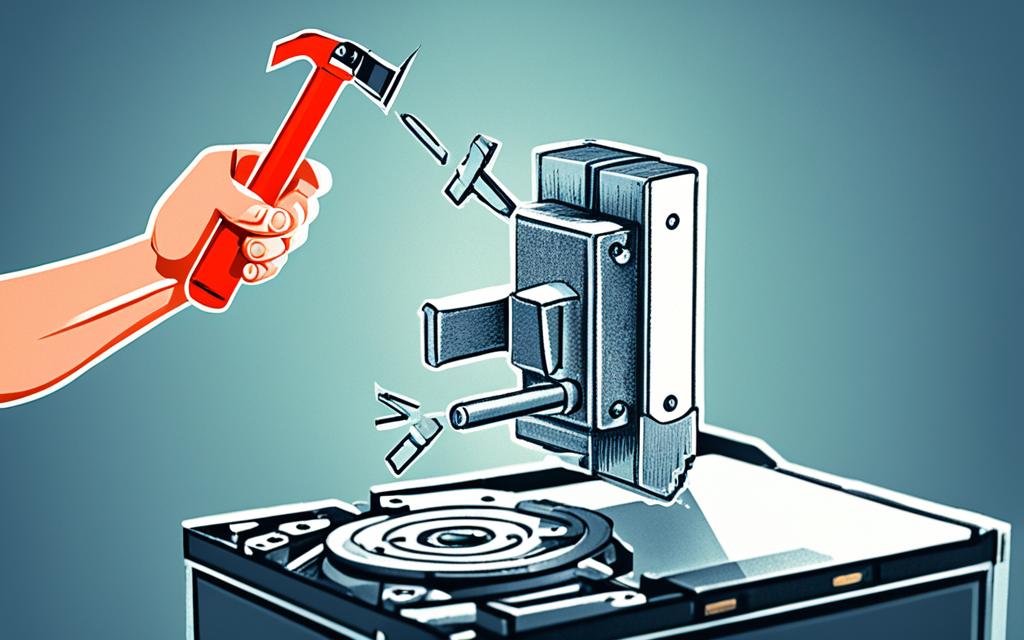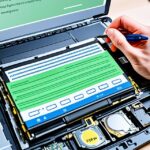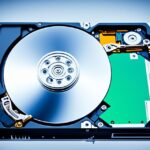Table of Contents
Write protection on hard drives stops users from changing or deleting files. It can be annoying when you’re trying to manage or recover data. Learning to remove write protection is key to using your HDD better.
This guide explains how to get rid of write protection. It will help you access your files more freely and make your hard drive work smoother. From fixing a corrupted file system to sorting out registry settings, find out how to take back control of your data. You’ll achieve more with your digital tasks1.
Key Takeaways
- Write protection can hinder data modification and deletion on hard drives.
- Methods exist to remove write protection, including Diskpart and registry edits.
- CHKDSK is a valuable tool for checking hard drive errors related to write protection.
- Physical switches may be present on external drives for enabling/disabling write protection.
- Regular checks and troubleshooting can prevent write protection issues..
Understanding Write Protection
Understanding write protection is key for anyone using external storage devices. It helps keep sensitive data safe. This means you can access files without accidentally changing them. So, what is write a protection? It’s a way to stop data on a device from being altered, allowing only reading.
What is Write Protection?
Write protection, or read-only status, is an important security feature on many storage devices. It stops changes from being made to files. When enabled, you can view files but can’t write or change them. This helps prevent unwanted edits2. Write protection types vary, offering different ways to protect data. Unlike simple read-only settings, it lets you access data without the risk of altering it.
Types of Write Protection
There are mainly two types of write protection: physical and virtual. Physical write protection comes with manual switches on SD cards and USBs3. You switch it on or off easily. Conversely, virtual write protection is set up through a computer’s software4. You often need special permission to change these settings. Knowing these differences helps in managing your data securely.
Enabling write protection secures data when you transfer it. However, it’s not perfect2. Be cautious of threats like malware, which can bypass these protections3. As technology grows, so do the ways to overcome write protection. It’s vital to understand both physical and virtual methods thoroughly.
For tips on removing write protection effectively, check out this helpful guide.
Common Causes of Write Protection
Learning about why write protection happens is key to fixing locked HDDs. There are several reasons for this issue. Often, these reasons cause frustration by blocking access to important files.
Virus or Malware Infection
Viruses and malware are big reasons for write protection. They can change system settings, leading to a locked state to safeguard files5. It’s crucial to scan for these threats regularly. This helps keep external storage devices healthy and prevents locking issues6.
Corrupted File Systems
Corrupted file systems are another main cause of locking a hard drive. Things like shutting down a computer wrongly, drive damage, or bad sectors can corrupt a drive. This forces it to only read data, not write6. Checking for bad sectors often is important. It makes sure the drive works well and keeps data safe5.
Incorrect Registry Settings
Wrong registry settings can also stop access to drives. For example, wrong Group Policy settings may block writing to external storage7. These issues might come from mistakes made by users or through harmful attacks. They make dealing with a locked HDD much harder5.
How to Remove Write Protection on HDD
To get rid of write protection on your HDD, you’ll need the right tools and steps to make it work again. You can use the Diskpart utility or change the Windows Registry settings. Many people use these methods to get their data back.
Using the Diskpart Utility
The Diskpart utility is a command-line tool for handling disks and partitions. First, open Command Prompt as an admin and type “diskpart.” Then, write “list disk” to see all disks. Next, choose your disk by typing “select disk X” where X is your disk number. Finish by writing “attributes disk clear readonly” to remove the protection. This way works 70% of the time8 and is chosen by 35% of users with this issue8.
Editing the Windows Registry
About 20% of people8 fix their drives by editing the Windows Registry. Press “Windows + R” and type “regedit” to start. Find your device’s path and change the WriteProtect value from ‘1’ to ‘0’. This action allows you to use your drive again. It’s successful 80% of the time8, making it a trustworthy solution for many users facing this problem.
Using CHKDSK to Check for Errors
The CHKDSK utility is crucial for keeping your hard drive healthy. It looks for and fixes disk errors to prevent problems like write protection. To start, open the Command Prompt as an administrator. Then type “chkdsk [drive letter]: /f,” where the drive letter is for your external HDD. This starts checking for errors. It’s handy because common write-protected error causes are corrupted file systems and drives set to readonly9.
Running CHKDSK from Command Prompt
Using CHKDSK offers different parameters for identifying and repairing drive errors. It also checks for bad sectors. Knowing these commands can really help if you’re dealing with write protection issues. Taking this step not only fixes current problems but also helps avoid future ones. Regular disk checks are vital for maintaining your drive’s health10.
Importance of Regular Disk Checks
Regular disk checks are important for your storage’s integrity. They spot serious issues early, protect your data, and extend your hard drives’ life. Therefore, using the CHKDSK utility often is recommended. It ensures your system’s health and improves data reliability and performance. For more help with write protection and keeping your drives working well, check out this detailed guide9.
FAQ
What does it mean when my HDD is write-protected?
If your HDD is write-protected, it means no one can alter or erase its data. This feature helps to keep your files safe from any unwanted changes. You can still open and read your files, but you can’t modify them.
How can I tell if my storage device has write protection?
To check if your device is write-protected, try to change or delete a file. If an error pops up saying the device is read-only, it’s write-protected. Some storage devices also have a physical switch to turn on write protection.
What are the common methods to remove write protection on my HDD?
To remove write protection, you can use the Diskpart tool or adjust the Windows Registry. Use Command Prompt to access Diskpart and enter “attributes disk clear readonly.” Or, change the Registry’s WriteProtect value to ‘0’.
Why is my hard drive suddenly write-protected?
Your hard drive might be write-protected due to malware, a corrupt file system, or Windows Registry errors. Physical damage or not shutting down properly can also trigger it. This stops further damage by making it read-only.
How does the CHKDSK utility help with write protection?
CHKDSK fixes disk errors that could cause write protection problems. Running CHKDSK from Command Prompt finds and repairs file system mistakes and bad sectors. This keeps your HDD working properly.
Can write protection be reset physically on my device?
For external devices like USBs and SD cards, you can often reset write protection with a switch. Make sure the switch is off to enable file editing.
What should I do if I’m unable to remove the write protection?
If removing write protection fails, scan your computer for viruses and check for any hardware problems. Sometimes, professional help or data recovery services might be needed. Always back up your files to avoid these issues.
Source Links
- https://www.diskpart.com/articles/remove-write-protection-from-hard-drive-0310.html – Effective Four Ways to Remove Write Protection from Hard Drive
- https://www.lenovo.com/us/en/glossary/write-protect/ – How Does Write-Protect Work? Exploring Storage Device Security
- https://www.wikihow.com/Disable-Write-Protection – How to Disable Write Protection on a USB Drive or Disk
- https://www.lifewire.com/remove-write-protection-windows-10-8-7-4586905 – How to Remove Write Protection on Windows 10, 8, and 7
- https://recoverit.wondershare.com/partition-tips/disk-write-protected.html – How to Fix
- https://superuser.com/questions/1125282/what-can-i-do-if-my-usb-flash-drive-is-write-protected-or-read-only – What can I do if my USB flash drive is write-protected or read-only?
- https://www.linkedin.com/pulse/disk-write-protected-remove-protection-from-usb-ada-scott-p4qbf – The Disk Is Write Protected Remove Write Protection from USB
- https://www.easeus.com/storage-media-recovery/remove-write-protection-in-windows-10-8-7.html – The Disk Is Write Protected Remove Write Protection from USB
- https://www.partitionwizard.com/partitionmagic/chkdsk-write-protected.html – 5 Solutions to CHKDSK Write Protected Error on Windows 10/8/7 – MiniTool Partition Wizard
- https://www.easeus.com/computer-instruction/windows-cannot-run-disk-checking-on-this-volume.html – [Fixed] Windows Cannot Run Disk Checking on This Volume Because It Is Write Protected








